Meaning, Format, Steps, Different types, Application, Example, Advantages | Accountancy - Journal entries | 11th Accountancy : Chapter 3 : Books of Prime Entry
Chapter: 11th Accountancy : Chapter 3 : Books of Prime Entry
Journal entries
Journal entries
The word
journal has been derived from the French word ‘Jour’ which means day. So,
journal means daily. Transactions are recorded daily in the journal as and when
the transactions take place. As soon as a transaction takes place, its debit
and credit aspects are analysed and recorded in the journal together with a
short description called narration. This facilitates making entries in the
ledger. Since transactions are first recorded in the journal, it is called book
of original entry or prime entry or primary entry or preliminary entry, or
first entry. Journalising is the beginning of the accounting process for the
financial transactions.
Meaning
Journal is
the book of original entry in which business transactions are recorded in
chronological order, that is, in the order of occurrence. Transactions are
recorded for the first time in the journal. Entries are made in the journal
based on source documents. Record of business transactions in the journal is
known as Journal entry. The process of recording the transactions in journal is
called as journalising.![]()
According to
Professor Carter, “The journal as originally used, is a book of prime entry in
which transactions are copied in order of date from a memorandum or waste book.
The entries as they are copied are classified into debits and credits, so as to
facilitate their being correctly posted, afterwards in the ledger”.
Format of Journal
The format of journal is given below:
In the books of……….Journal

A journal
contains five columns; Date, Particulars, L.F., Debit and Credit.
Date column: In this column the date
of the transaction is recorded.
Particulars column: The accounts involved
in the transaction are recorded in this column. The account debited is recorded first with the word ‘Dr.’ entered
towards the end of the row and the account credited is entered in the next line
after leaving a little space on the left and preceded by the word ‘To’.
Leder Folio column (L.F.): The page
number of ledger in which the accounts debited and credited are maintained is recorded here. Folio means page and ledger folio
means page number of ledger. This L.F. helps in cross verification of accounts
in the ledger and helps in audit of accounts.
Debit column: The amount to be
debited is recorded in this column. The unit of measurement, that is, amount expressed in the
currency of the country is recorded in this column. For example, in India
amount is recorded in rupees (Rs.).
Credit column: The amount to be
credited is recorded in this column. The unit of measurement, that is, the currency of the country
is written in this column. For example, in India amount is recorded in rupees (Rs.).
Narration: A short description of
each transaction is written under each entry which is called narration.
Tutorial note
·
While entering the date, the year may be written at
the top, then the month and then the particular date.
·
The
narration must be simple and complete. The words ‘Being’ or ‘For’ may also be
prefixed before the narration.
·
It is
customary to write ‘Dr’ and ‘To’ in the journal entries.
·
L.F.
column is filled when the transaction is posted to the ledger. In computerised
accounting, it is the reference number.
· The amount columns of a journal may be totalled at the end of the each page and the grand total may be given at the end of the month.
·
To show
each journal entry separately, a line may be drawn after narration in
particulars column.
· When transactions of similar nature take place on the same date, they may be combined while they are journalised.
Steps in journalising
The process of analysing the business transactions
under the heads of debit and credit and recording them in the journal is called
journalising. An entry made in the journal is called a journal entry. The
following steps are followed in journalising:
• Analyse
the transactions and identify the accounts (based on aspects) which are involved
in the transaction.
• Classify
the above accounts under Personal account, Real account or Nominal account
• Apply the
rules of debit and credit for the above two accounts.
• Find which
account is to be debited and which account is to be credited by the application
of rules of double entry system Record the date of transaction in the date
column.
• Enter the
name of the account to be debited in the particulars column very close to the
left hand side of the particulars column followed by the abbreviation ‘Dr.’ at
the end in the same line. Against this, the amount to be debited is entered in
the debit amount column in the same line.
• Write the
name of the account to be credited in the second line starting with the word
‘To’ prefixed a few spaces away from the margin in the particulars column.
Against this, the amount to be credited is entered in the credit amount column
in the same line.
• Write the
narration within brackets in the next line in the particulars column.
Different types of journal entries
The journal entries may be of the following types:
a. Single entry
b. Compound entry
c. Opening entry
d. Closing entry
e. Rectifying entry
f. Adjusting entry
g. Transferring entry
Single entry: Single entry
is an entry in which only two accounts are involved, one account is debited and another
is credited.
Compound entry: Compound
entry is an entry in which more than two accounts are involved. Either more than one
account is debited or more than one account is credited or both.
Opening entry: Through
opening entry the balances of assets and liabilities at the end of the
previous accounting year are brought forward to the current accounting year.
This is dealt in chapter 6.
Closing entry: At the end of
the accounting period, the nominal accounts are closed by transferring to trading account
or profit and loss account. All direct expenses and direct revenues are
transferred to Trading Account. All indirect expenses and indirect revenues are
transferred to Profit and Loss Account. This is dealt in chapter 6.
Rectifying entry: Rectifying
entries are passed to make correction of errors in accounting. This
is dealt in chapter 9.
Adjusting entry: Adjusting
entry is the entry made for the transactions which remain unrecorded or require
adjustment after closing the accounts for the accounting year. This is dealt in
chapter 13.
Transfer entry: Transfer
entry is the entry through which amount is transferred from one account to another account.
Application of rules of double entry system
Rules of
double entry system of book-keeping are applied for business transactions as
follows:
i. Personal account
‘Debit the
receiver and Credit the giver’. In case of personal accounts, the rule is debit
the account of the person who receives the benefit and credit the account of
the person who gives the benefit.
Example : Paid Anbu Rs. 10,000 by cheque
Accounts
affected : Anbu account and Bank account
Nature of
accounts : Both are personal
accounts in nature
Rule :
Debit the receiver and credit the giver
Applying the
rule : Anbu is the receiver and the Bank
is the giver
Debit : Anbu account
Credit : Bank account
ii. Real account
‘Debit what comes in and Credit what goes out’. In
case of real accounts, the rule is debit what comes in and credit what goes
out.
Example : Furniture
purchased for cash Rs. 5,000
Accounts
affected : Furniture
account and Cash account
Nature of
accounts : Both are real accounts in nature
Rule : Debit
what comes in and credit what goes out
Applying the
rule : Furniture
comes in and cash goes out
Debit : Furniture account
Credit : Cash
account
iii .Nominal account
‘Debit all
expenses and losses and Credit all incomes and gains’. For nominal accounts,
the rule is debit all expenses and losses and credit all incomes and gains.
Example : Paid rent of Rs. 5,000 in cash
Accounts
affected : Rent
account and cash account
Nature of
accounts : Rent is a nominal account and cash account is a real account
Rule : Debit
all the expenses and losses and credit all the incomes and gains
Applying the
rule : Rent
is an expense and cash goes out
Debit Rent account
Credit Cash account
Analysis of transactions
Example 1
Transaction: Somu commenced printing
business with cash Rs. 50,000.
Analysis: This is a cash transaction as cash is involved.

Example 2
Transaction: Bought goods for cash Rs. 4,000
Analysis: This is a cash transaction as cash is involved.


Example 3
Transaction: Purchased goods from Rahul for Rs. 10,000 on
credit
Analysis: This is a credit transaction.
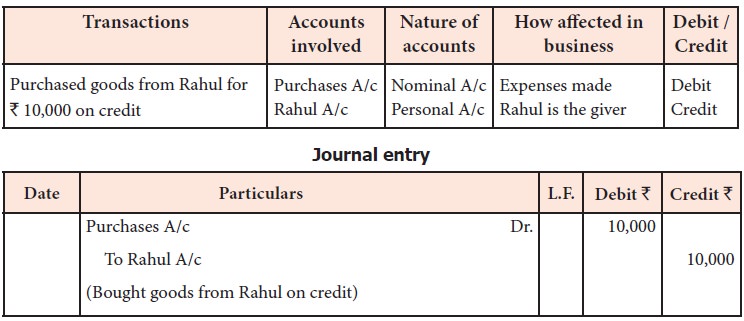
Example 4
Transaction: Cash paid to Rahul Rs. 4,000
Analysis: This is a cash transaction as cash is involved.
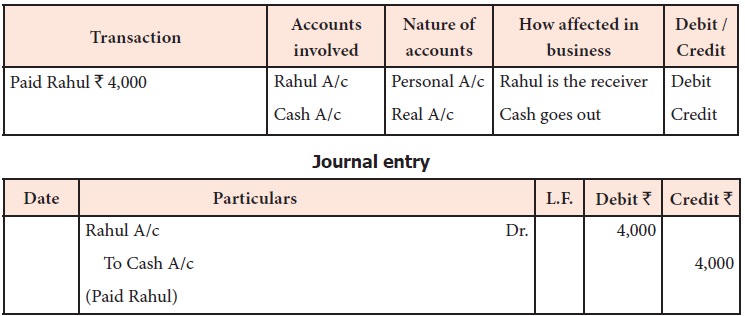
Example 5
Transaction: Withdrew cash for personal use Rs. 8,000
Analysis: This is a cash transaction as cash is involved.
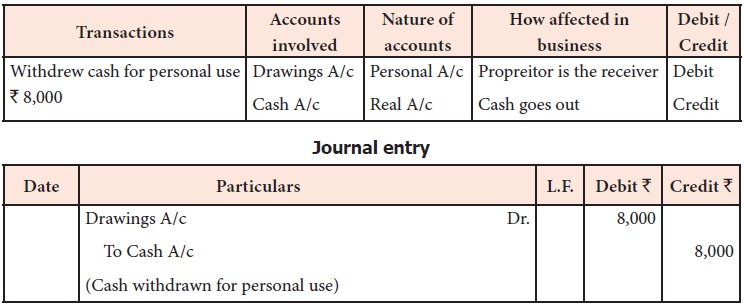
Example 6
Transaction: Cash deposited into bank Rs. 5,000
Analysis: This is a cash transaction as cash is involved.
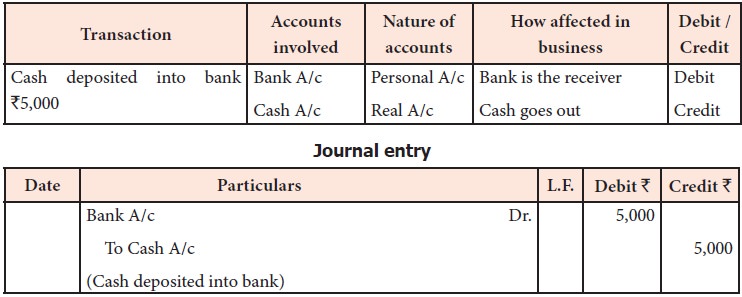
Example 7
Transaction: Paid salary by cheque Rs. 3,000
Analysis: This is a bank transaction as bank is involved.


Example 8
Transaction: Sold goods to Mahesh on credit Rs. 9,000
Analysis: This is a credit transaction.
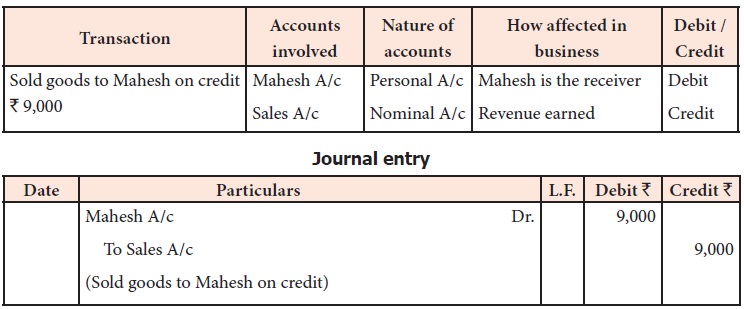
Example 9
Transaction: Goods sold to Mahendran for cash Rs. 5,000
Analysis: This is a cash transaction as cash is involved.
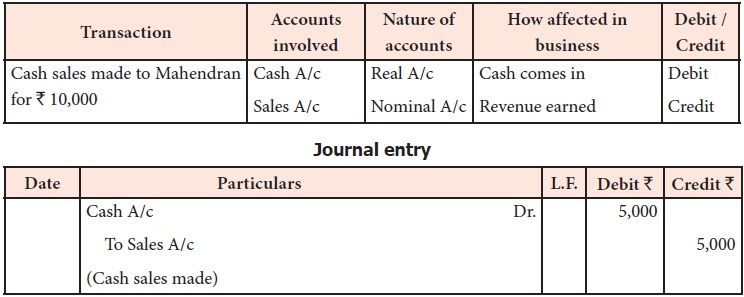
Example 10
Transaction: Borrowed loan from Bank Rs. 10,000
Analysis: This is a cash transaction as cash is involved.
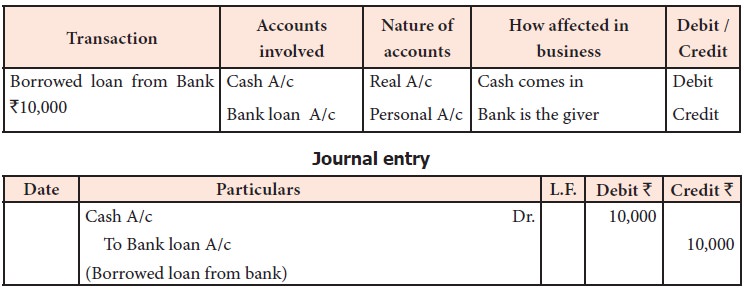
Example 11
Transaction: Received commission of Rs. 5,000 by cash
Analysis: This is a cash transaction as cash is involved.
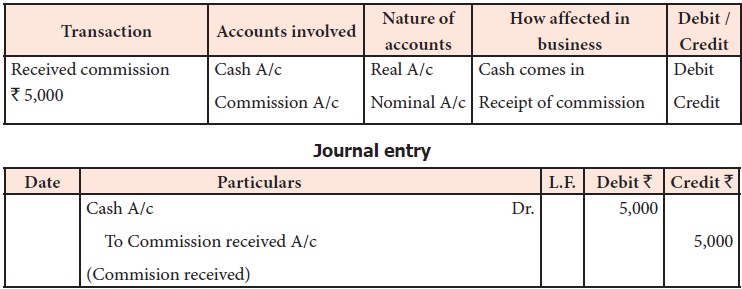
Example 12
Transaction:
Paid Rs. 4,800 in full settlement of Rs. 5,000 due to the creditor, Keerthana.
Analysis: This is a cash transaction as cash is involved.

Example 13
Transaction:
Dinesh, a customer is declared
insolvent and 40 paise in a rupee is received from the estate for his due Rs. 10,000.
Analysis: This is a cash transaction as cash is involved.
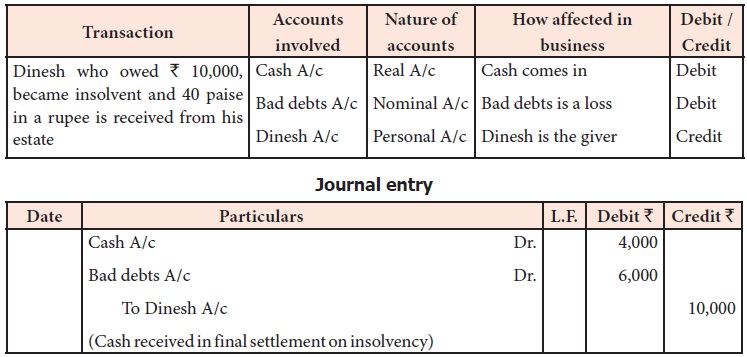
Tutorial note
Though the
procedure for analysis of transactions, classification of accounts and rules
for recording transactions under accounting equation approach and traditional
approach are different, the accounts affected and entries in affected accounts
remain the same under both approaches. In other words, accounts to be debited
and credited to record the dual aspect remain the same under both the
approaches.
Illustration 8
Jeyaseeli is a sole proprietor having a provisions
store. Following are the transactions during the month of January, 2018.
Journalise them.
Jan. Rs.
1 Commenced business with cash 80,000
2 Deposited cash with bank 40,000
3 Purchased goods by paying cash 5,000
4 Purchased goods from Lipton & Co. on
credit 10,000
5 Sold goods to Joy and received cash 11,000
6 Paid salaries by cash 5,000
7 Paid Lipton & Co. by cheque for the purchases
made on 4th Jan.
8 Bought furniture by cash 4,000
9 Paid electricity charges by cash 1,000
10 Bank paid insurance premium on furniture as per
standing instructions 300
Solution
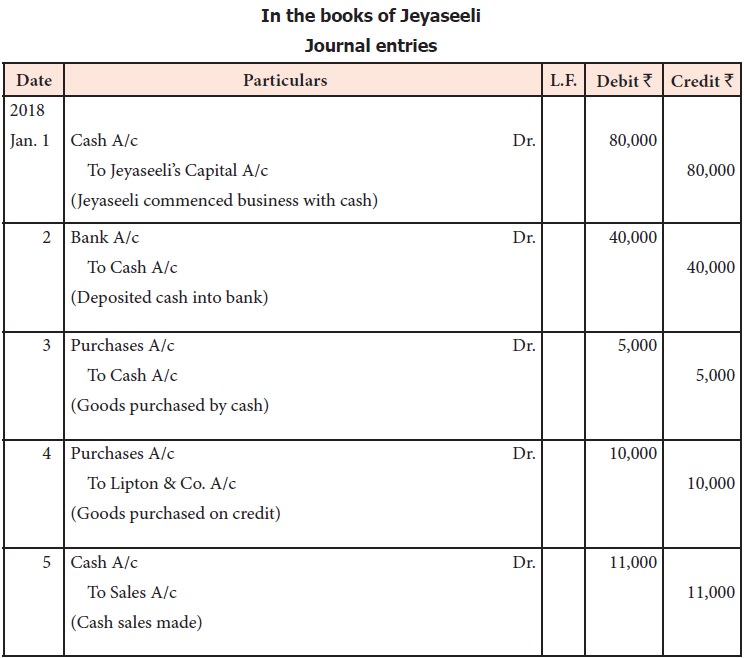
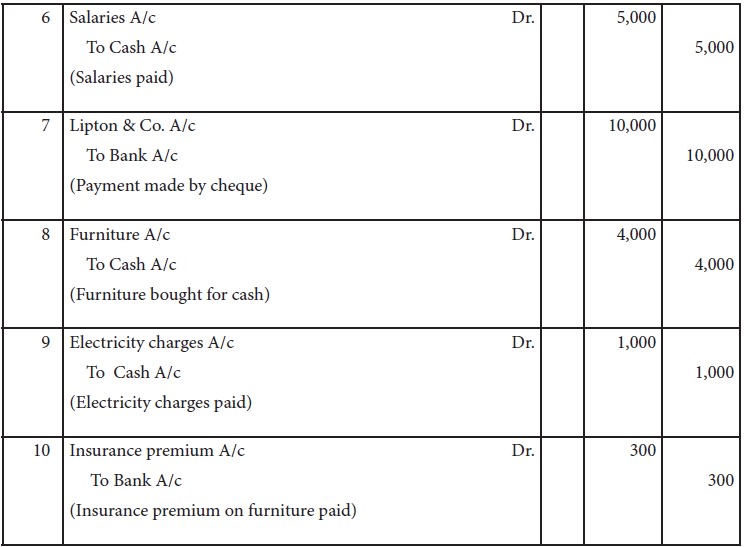
Illustration 9
Ananth is a trader dealing in textiles. For the
following transactions, pass journal entries for the month of January, 2018.
Jan. Rs.
1 Commenced business with cash 70,000
2 Purchased goods from X and Co. on credit 30,000
3 Cash deposited into bank 40,000
4 Bought a building from L and Co. on credit 95,000
5 Cash withdrawn from bank for office use 5,000
6 Cash withdrawn from bank for personal use of
Ananthu 4,000
7 Towels given as charities 3,000
8 Shirts taken over by Ananth for personal use 12,000
9 Sarees distributed as free samples 3,000
10 Goods (table clothes) used for office use 200
Solution
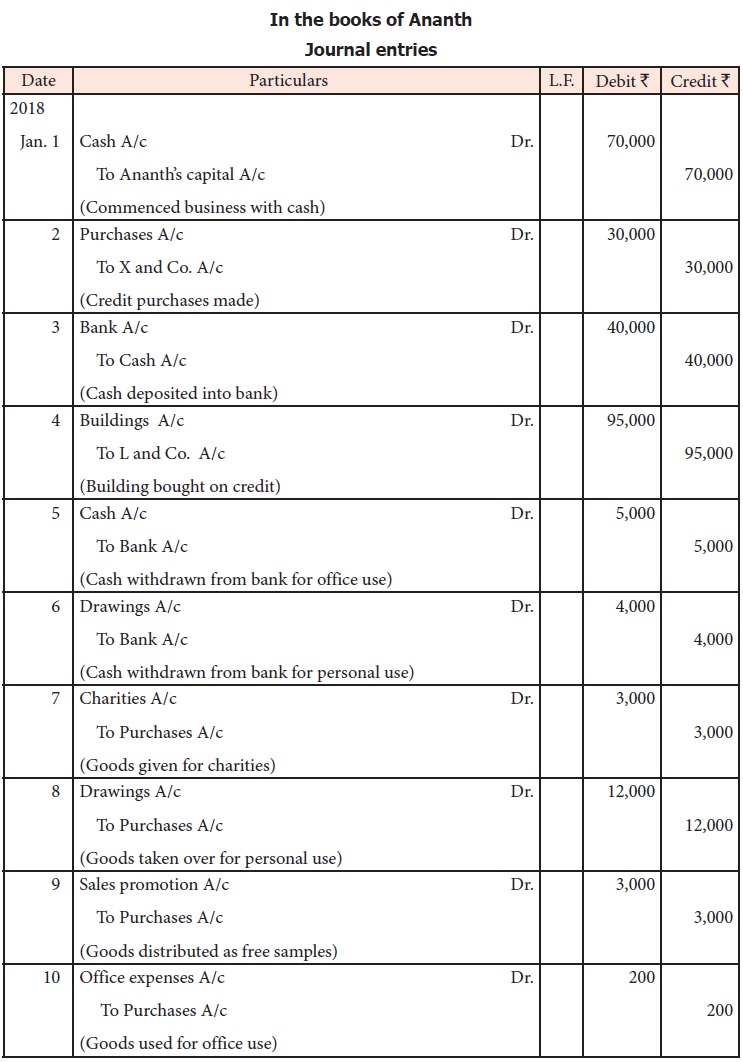
Illustration 10
Arun is a trader dealing in automobiles. For the
following transactions, pass journal entries for the month of January, 2018
Jan. Rs.
1 Commenced business with cash 90,000
2 Purchased goods from X and Co. on credit 40,000
3 Accepted bill drawn by X and Co. 20,000
4 Sold goods to D and Co. on credit 10,000
5 Paid by cash the bill drawn by X and Co.
6 Received cheque from D and Co. in full
settlement and deposited the same in bank 9,000
7 Commission received in cash 5,000
8 Goods costing Rs. 40,000 was sold and cash
received 50,000
9 Salaries paid in cash 4,000
10 Building purchased from Kumar and Co. for Rs.
1,00,000 and an advance of Rs. 20,000 is given in cash
Solution
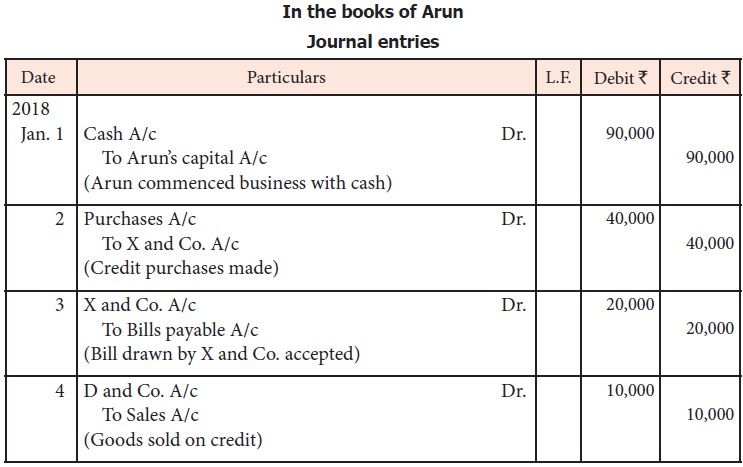
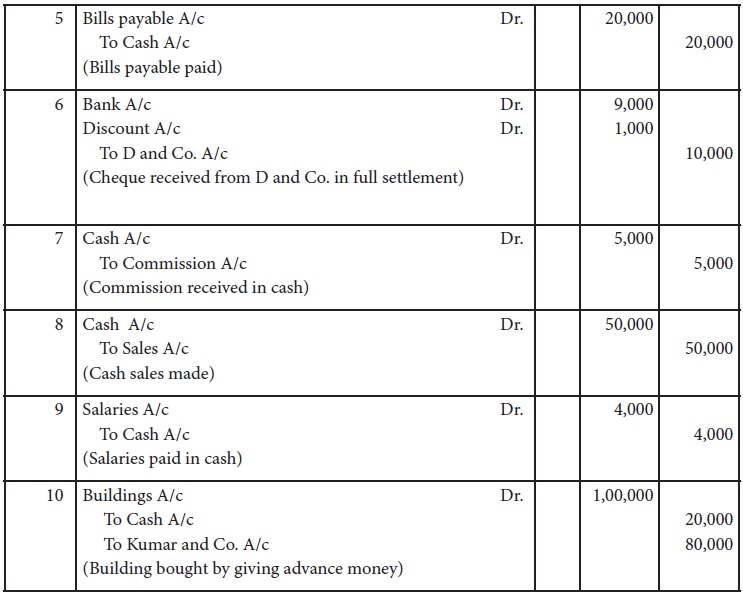
Illustration 11
Bragathish is a trader dealing in electronic goods
who commenced his business in 2015. For the following transactions took place
in the month of March 2018, pass journal entries.
March Rs.
1. Purchased goods from Y and Co. on credit 60,000
2. Sold goods to D and Co. on credit 30,000
3. Paid Y and Co. through bank in full settlement 58,000
4. D and Co. accepted a bill drawn by Bragathish 30,000
5. Sold goods to L on credit 20,000
6. Sold goods to M on credit 40,000
7 Received a cheque from M in full settlement and deposited the same to the bank 39,000
8. Goods
returned to Y and Co. 4,000
9. L became insolvent and only 90 paise per rupee
is received by cash in final settlement
10. Goods returned by M 3,000
Solution
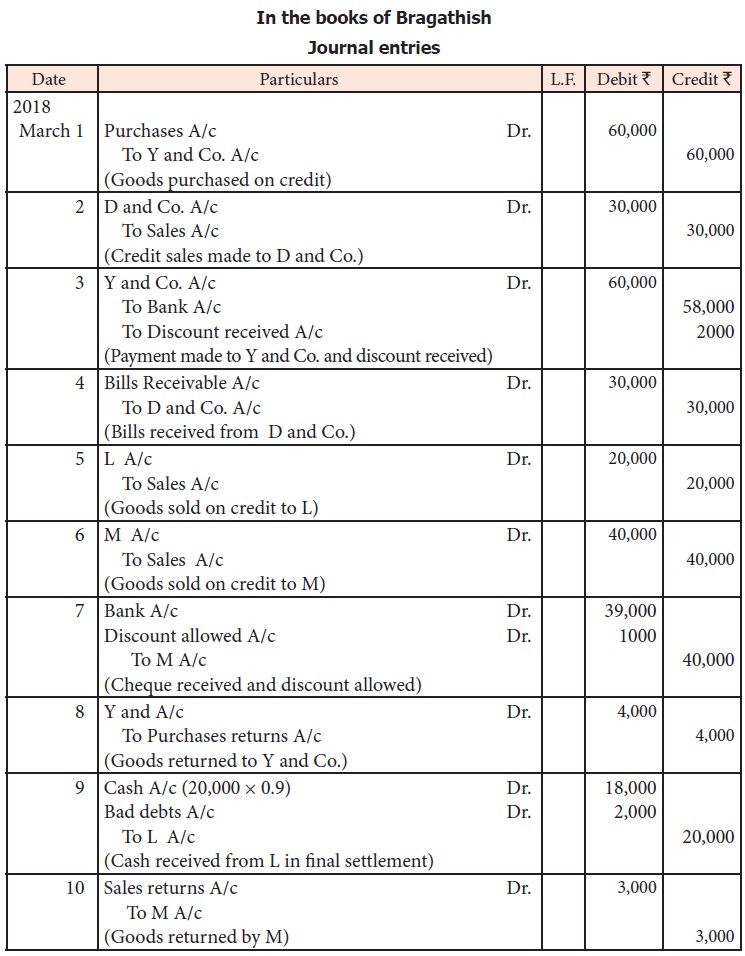
Illustration 12
Valluvar is a sole trader dealing in textiles. From
the following transactions, pass journal entries for the month of March, 2018.
March Rs.
1 Commenced business with cash 90,000
with goods 60,000
2 Purchased 20 readymade shirts from X and Co.
on credit 10,000
3 Cash deposited into bank through Cash Deposit
Machine 30,000
4 Purchased 10 readymade sarees from Y and Co.
by cash 6,000
5 Paid X and Co. through NEFT
6 Sold 5 sarees to A and Co. on credit 4,000
7 A and Co. deposited the amount due in Cash
Deposit Machine
8 Purchased 20 sarees from Z & Co. and paid
through debit card 12,000
9 Stationery purchased for and paid through net
banking 6,000
10 Bank charges levied 200
Solution

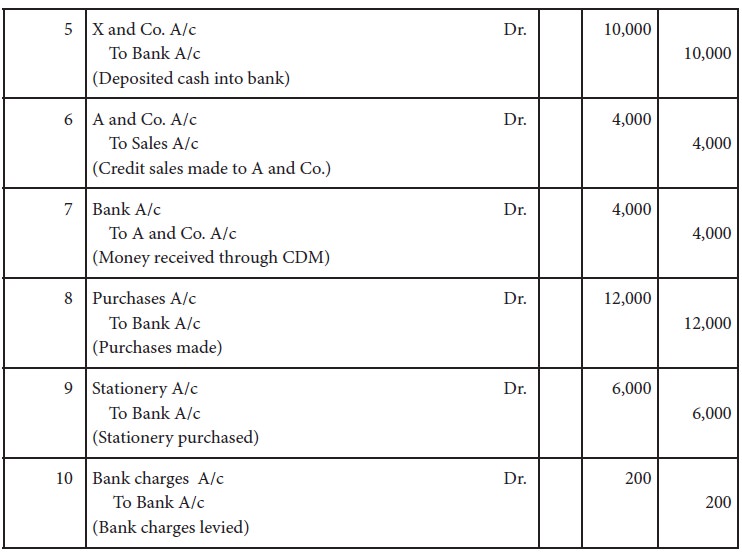
Illustration 13
Deri is a sole trader dealing in automobiles. From
the following transactions, pass journal entries for the month of January,
2018.
Jan. Rs.
1 Commenced business with cash 1,00,000
with goods 2,00,000
with buildings 5,00,000
2 Purchased goods from A and Co. on credit 3,00,000
3 Cash deposited into bank 80,000
4 Purchased goods from B and Co. and payment made through credit card 5,000
5 Paid A and Co. through RTGS
6 Sold goods to C and Co. and cheque received 50,000
7 Deposited the cheque received from C and Co.
with the bank
8 Purchased goods from Z & Co. and paid
through debit card 12,000
9 Stationery
purchased for and paid through net banking 6,000
10 Income
tax of Deri is paid by cheque 10,000
Solution

Illustration 14
Chandran is a sole trader dealing in sports items.
From the following transactions, pass journal entries for the month of March,
2018.
March Rs.
1 Commenced business with cash 4,00,000
2 Cash deposited into bank 3,00,000
3 Purchased goods from Ravi and payment made
through net banking 90,000
4 Sales made to Kumar, who deposited the money
through CDM 10,000
5 Sales made to Vivek, who made the payment by
debit card 60,000
6 Sold goods to Keerthana, who made the payment
through credit card 50,000
7 Dividend directly received by bank 2,000
8 Money withdrawn from ATM 3,000
9 Salaries paid through ECS 6,000
10 Cricket bats donated to a trust 10,000
Solution
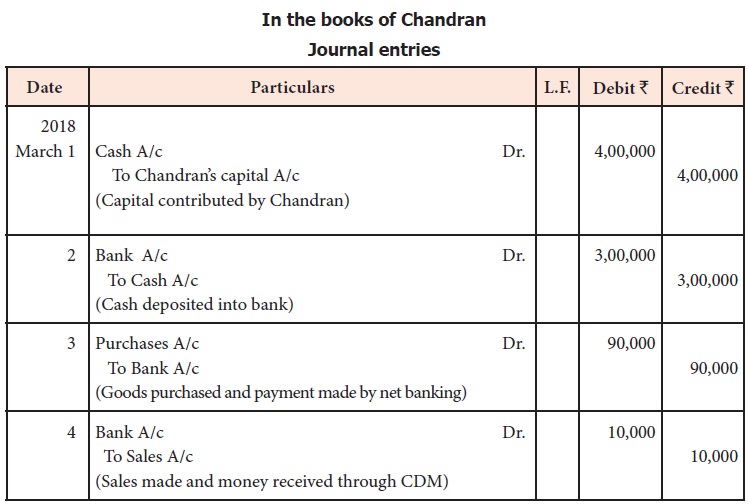
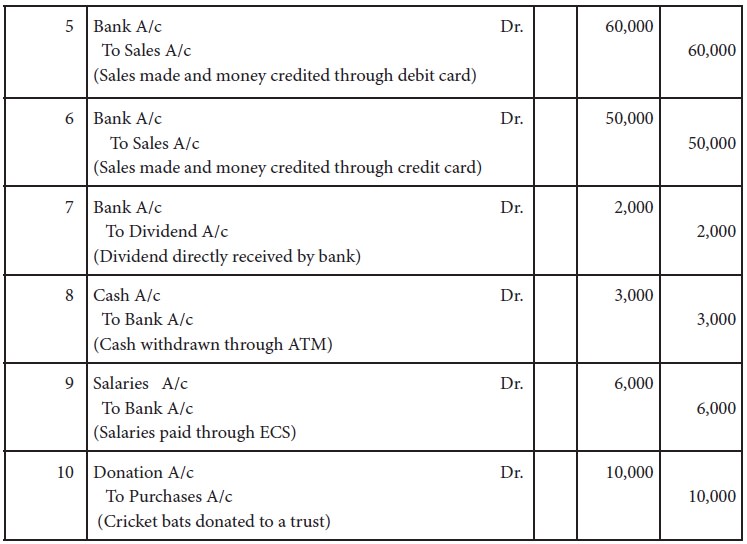
Illustration 15
Deepak is a dealer in stationery items. From the
following transactions, pass journal entries for the month of January and
February, 2018.
Jan. Rs.
1 Commenced business with cash 2,00,000
2 Opened a bank account by depositing cash 1,00,000
3 ‘A 4 papers’ sold on credit to Padmini and
Co. 60,000
4 Bills received from Padmini and Co. for the
amount due
5 Bills received from Padmini and Co.
discounted with the bank 58,000 Feb.
15 Bills of Padmini and Co. dishonoured
Solution
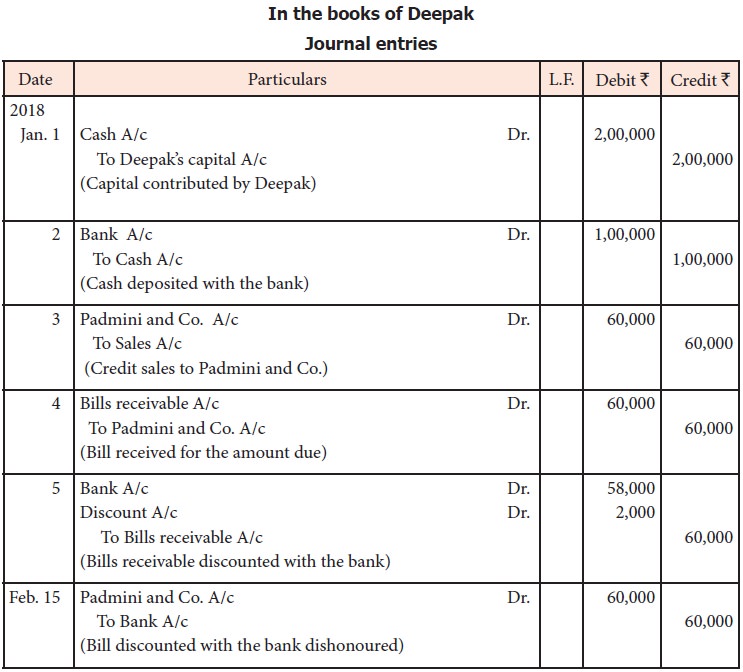
Advantages of journal
Following are the advantages of journal:
• Complete information about the business
transactions can be obtained on time basis as the transactions are recorded in
chronological order.
• Correctness of the entry can be checked
through narration.
• Journal forms the basis for posting the
entries in the ledger.
Related Topics